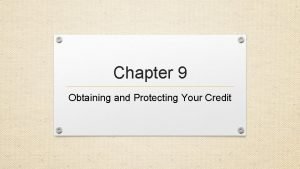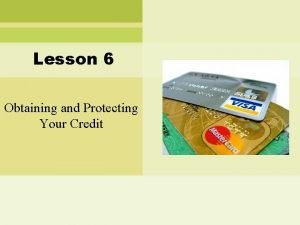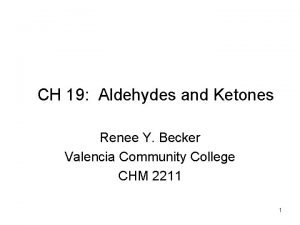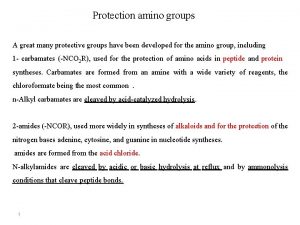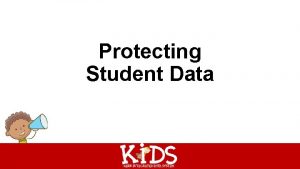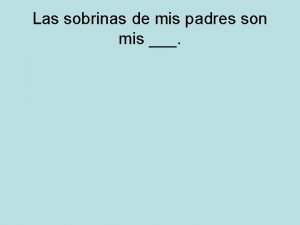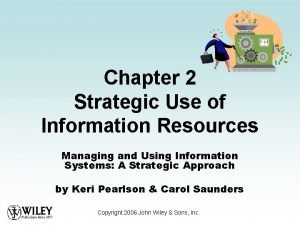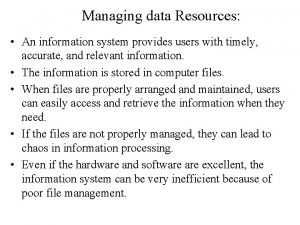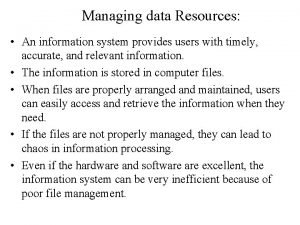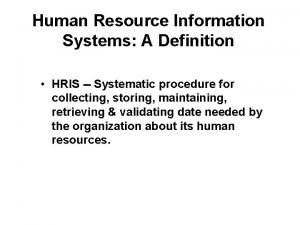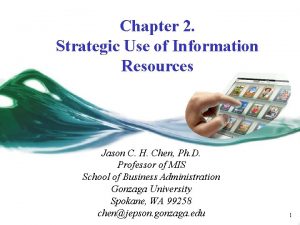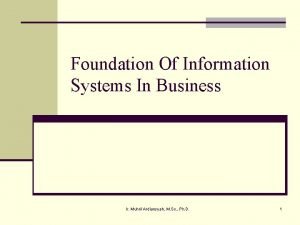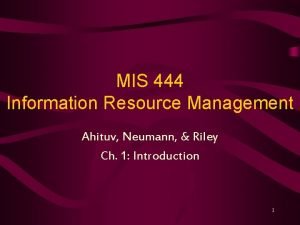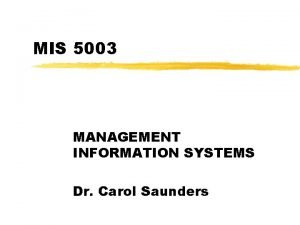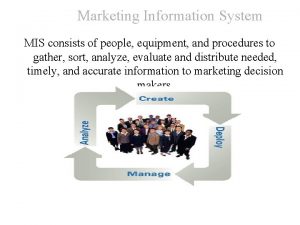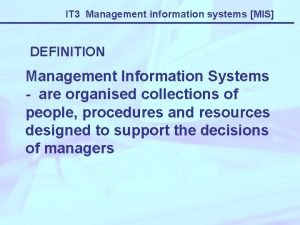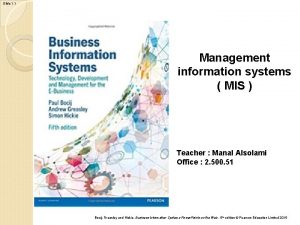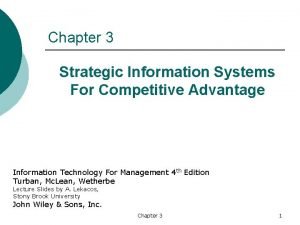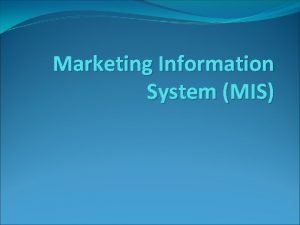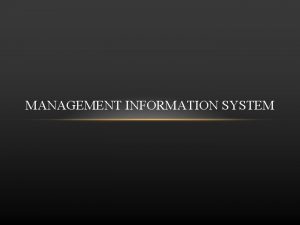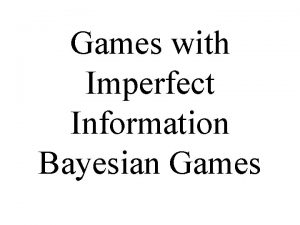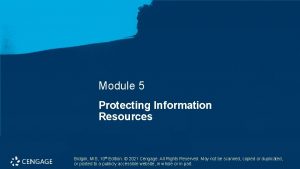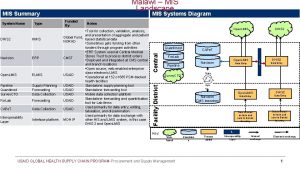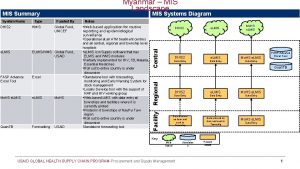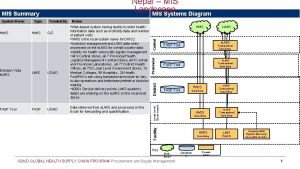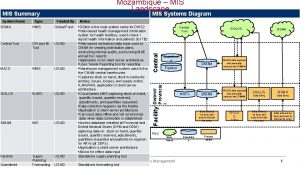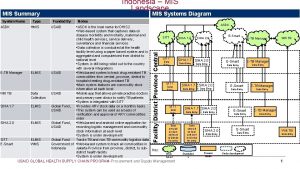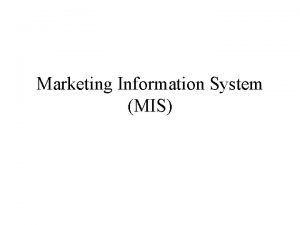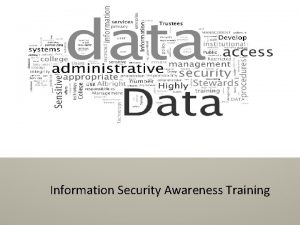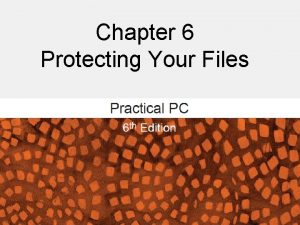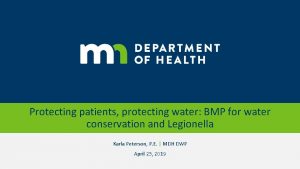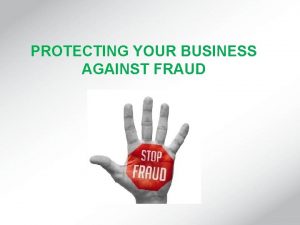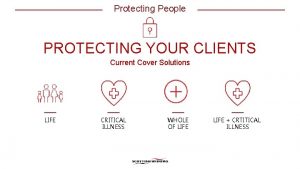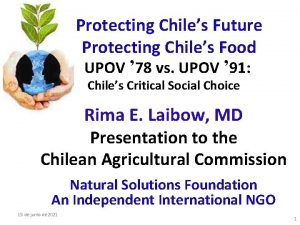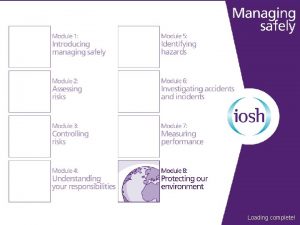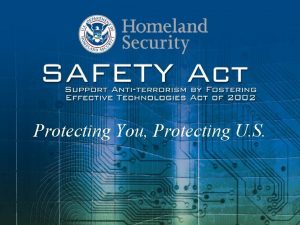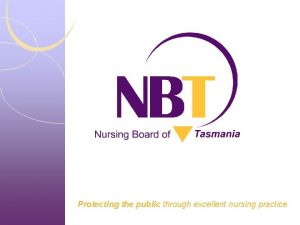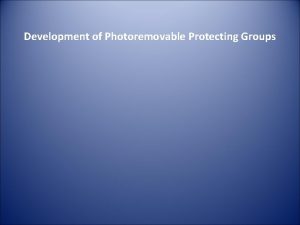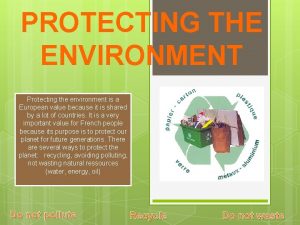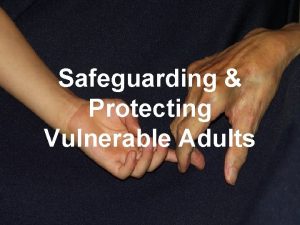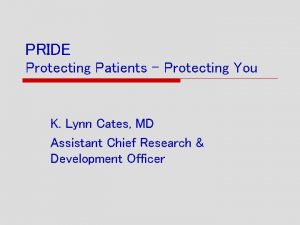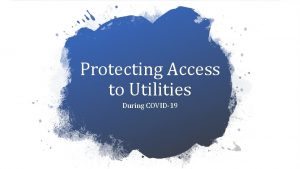MIS CHAPTER 5 PROTECTING INFORMATION RESOURCES MIS Chapter













































- Slides: 45

MIS CHAPTER 5 PROTECTING INFORMATION RESOURCES MIS, Chapter 5 © 2011 Course Technology, a part of Cengage Learning Hossein BIDGOLI 1

Chapter 5 Protecting Information Resources learning outcomes LO 1 Describe basic safeguards in computer and network security. LO 2 LO 3 LO 4 Explain the major security threats. Describe security and enforcement measures. Summarize the guidelines for a comprehensive security system, including business continuity planning. MIS, Chapter 5 © 2011 Course Technology, a part of Cengage Learning 2

Chapter 5 Protecting Information Resources Is Facebook a Friend or Fiend? • In 2010, a hacker named Kirllos was peddling 1. 5 million stolen Facebook accounts for as little as 2. 5 cents per account • If true, that would mean that one out of every 300 Facebook users were, unbeknownst to them, on the market • Cyber criminals use stolen accounts to spam, scam, and otherwise profit from unwary Facebook users, who are likely to respond to a familiar face or name without realizing that the friend is a fiend MIS, Chapter 5 © 2011 Course Technology, a part of Cengage Learning 3

Chapter 5 Protecting Information Resources Computer and Network Security: Basic Safeguards • Critical for most organizations – Especially in recent years, with “hackers” becoming more numerous and adept at stealing and altering private information • Hackers use a variety of tools to break into computers and networks – Sniffers, password crackers, and rootkits – Journals Phrack and 2600: The Hacker Quarterly MIS, Chapter 5 © 2011 Course Technology, a part of Cengage Learning 4

Chapter 5 Protecting Information Resources Computer and Network Security: Basic Safeguards (cont’d. ) • Comprehensive security system – Protects an organization’s resources – Including information and computer and network equipment, e-mails, invoices transferred via electronic data interchange (EDI), new product designs, marketing campaigns, and financial statements • Threats – Include sharing passwords with coworkers, leaving a computer unattended while logged on to the network, or even spilling coffee on a keyboard MIS, Chapter 5 © 2011 Course Technology, a part of Cengage Learning 5

Chapter 5 Protecting Information Resources Computer and Network Security: Basic Safeguards (cont’d. ) • Comprehensive security system – Includes hardware, software, procedures, and personnel that collectively protect information resources • Confidentiality – System must not allow disclosing information to anyone who isn’t authorized to access it – Secure government agencies – Businesses – E-commerce MIS, Chapter 5 © 2011 Course Technology, a part of Cengage Learning 6

Chapter 5 Protecting Information Resources Computer and Network Security: Basic Safeguards (cont’d. ) • Integrity – Ensures the accuracy of information resources in an organization – Financial transactions • Availability – Ensures that computers and networks are operating – Authorized users can access the information they need MIS, Chapter 5 © 2011 Course Technology, a part of Cengage Learning 7

Exhibit 5. 1 MIS, Chapter 5 © 2011 Course Technology, a part of Cengage Learning The Mc. Cumber Cube 8

Chapter 5 Protecting Information Resources Computer and Network Security: Basic Safeguards (cont’d. ) • Three levels of security – Level 1: front-end servers – Level 2: back-end systems – Level 3: corporate network • Fault-tolerant systems – Combination of hardware and software for improving reliability – Uninterruptible power supply (UPS) – Redundant array of independent disks (RAID) – Mirror disks MIS, Chapter 5 © 2011 Course Technology, a part of Cengage Learning 9

Chapter 5 Protecting Information Resources Security Threats: An Overview • Some threats can be controlled completely or partially, but some can’t be controlled • Categories – Unintentional – Intentional MIS, Chapter 5 © 2011 Course Technology, a part of Cengage Learning 10

Chapter 5 Protecting Information Resources Intentional Threats • • • Viruses Worms Trojan programs Logic bombs Backdoors Blended threats (e. g. , worm launched by Trojan) Rootkits Denial-of-service attacks Social engineering MIS, Chapter 5 © 2011 Course Technology, a part of Cengage Learning 11

Chapter 5 Protecting Information Resources Viruses • Type of malware • In 2008, the number of computer viruses in existence exceeded one million • Estimating the dollar amount of damage viruses cause can be difficult • Usually given names – I Love You, Michelangelo • Consists of self-propagating program code that’s triggered by a specified time or event MIS, Chapter 5 © 2011 Course Technology, a part of Cengage Learning 12

Chapter 5 Protecting Information Resources Viruses (cont’d. ) • Seriousness of viruses varies • Transmitted through a network and e-mail attachments – Bulletin or message boards • Virus hoaxes – Can cause as much damage as real viruses • Indications of a computer infected by a virus • Best measure against viruses – Installing and updating antivirus programs MIS, Chapter 5 © 2011 Course Technology, a part of Cengage Learning 13

Chapter 5 Protecting Information Resources Worms • Travel from computer to computer in a network – Do not usually erase data • Independent programs that can spread themselves without having to be attached to a host program • Replicate into a full-blown version that eats up computing resources • Well-known worms – Code Red, Melissa, and Sasser MIS, Chapter 5 © 2011 Course Technology, a part of Cengage Learning 14

Chapter 5 Protecting Information Resources Trojan Programs • Named after the Trojan horse the Greeks used to enter Troy during the Trojan Wars • Contains code intended to disrupt a computer, network, or Web site • Usually hidden inside a popular program MIS, Chapter 5 © 2011 Course Technology, a part of Cengage Learning 15

Chapter 5 Protecting Information Resources Logic Bombs • Type of Trojan program used to release a virus, worm, or other destructive code • Triggered at a certain time or by an event MIS, Chapter 5 © 2011 Course Technology, a part of Cengage Learning 16

Chapter 5 Protecting Information Resources Backdoors • Programming routine built into a system by its designer or programmer • Enable the designer or programmer to bypass system security and sneak back into the system later to access programs or files • System users aren’t aware a backdoor has been activated MIS, Chapter 5 © 2011 Course Technology, a part of Cengage Learning 17

Chapter 5 Protecting Information Resources Blended Threats • Combine the characteristics of computer viruses, worms, and other malicious codes with vulnerabilities found on public and private networks • Main goal is not just to start and transmit an attack, but also to spread it • Multi-layer security system could guard against blended threats MIS, Chapter 5 © 2011 Course Technology, a part of Cengage Learning 18

Chapter 5 Protecting Information Resources Denial-of-Service Attacks • Flood a network or server with service requests – Prevent legitimate users’ access to the system • Target Internet servers • Distributed denial-of-service (DDo. S) attack – Hundreds or thousands of computers work together to bombard a Web site with thousands of requests for information in a short period – Difficult to trace MIS, Chapter 5 © 2011 Course Technology, a part of Cengage Learning 19

Chapter 5 Protecting Information Resources Social Engineering • Using “people skills” to trick others into revealing private information – Takes advantage of the human element of security systems • Use the private information they’ve gathered to break into servers and networks and steal data • Commonly used social-engineering techniques – “Dumpster diving” and “shoulder surfing” MIS, Chapter 5 © 2011 Course Technology, a part of Cengage Learning 20

Chapter 5 Protecting Information Resources Protecting Against Data Theft and Data Loss • Portable storage media – Theft or loss of media – Stealing company data • Guidelines to protect against these risks MIS, Chapter 5 © 2011 Course Technology, a part of Cengage Learning 21

Chapter 5 Protecting Information Resources Security Measures and Enforcement: An Overview • • Biometric security measures Nonbiometric security measures Physical security measures Access controls Virtual private networks Data encryption E-commerce transaction security measures Computer Emergency Response Team MIS, Chapter 5 © 2011 Course Technology, a part of Cengage Learning 22

Chapter 5 Protecting Information Resources Biometric Security Measures • Use a physiological element to enhance security measures • Devices and measures – – – – Facial recognition Fingerprints Hand geometry Iris analysis Palmprints Retinal scanning Signature analysis MIS, Chapter 5 © 2011 Course Technology, a part of Cengage Learning – Vein analysis – Voice recognition 23

Chapter 5 Protecting Information Resources Biometrics at Phoebe Putney Memorial Hospital • Phoebe Putney Memorial Hospital switched to fingerprint scanners, which, along with a single sign-on application, made the electronic health record system both easier to use and more secure • Another advantage of fingerprint scanners: They don’t tend to get lost, like smart cards MIS, Chapter 5 © 2011 Course Technology, a part of Cengage Learning 24

Exhibit 5. 2 MIS, Chapter 5 © 2011 Course Technology, a part of Cengage Learning Examples of Biometric Devices 25

Chapter 5 Protecting Information Resources Nonbiometric Security Measures • Main security measures: – Callback modems – Firewalls – Intrusion detection systems MIS, Chapter 5 © 2011 Course Technology, a part of Cengage Learning 26

Chapter 5 Protecting Information Resources Callback Modems • Verify whether a user’s access is valid by: – Logging the user off – Calling the user back at a predetermined number • Useful in organizations with many employees who work off-site MIS, Chapter 5 © 2011 Course Technology, a part of Cengage Learning 27

Chapter 5 Protecting Information Resources Firewalls • Combination of hardware and software • Act as a filter or barrier between a private network and external computers or networks • Network administrator defines rules for access • Examine data passing into or out of a private network – Decide whether to allow the transmission based on users’ IDs, the transmission’s origin and destination, and the transmission’s contents MIS, Chapter 5 © 2011 Course Technology, a part of Cengage Learning 28

Exhibit 5. 3 MIS, Chapter 5 © 2011 Course Technology, a part of Cengage Learning A Basic Firewall Configuration 29

Chapter 5 Protecting Information Resources Firewalls (cont’d. ) • Possible actions after examining packet – Reject the incoming packet – Send a warning to the network administrator – Send a message to the packet’s sender that the attempt failed – Allow the packet to enter (or leave) the private network MIS, Chapter 5 © 2011 Course Technology, a part of Cengage Learning 30

Chapter 5 Protecting Information Resources Firewalls (cont’d. ) • Main types of firewalls – Packet-filtering firewalls – Application-filtering firewalls – Proxy servers MIS, Chapter 5 © 2011 Course Technology, a part of Cengage Learning 31

Exhibit 5. 4 MIS, Chapter 5 © 2011 Course Technology, a part of Cengage Learning A Proxy Server 32

Chapter 5 Protecting Information Resources Intrusion Detection Systems • • • Protect against both external and internal access Placed in front of a firewall Prevent against Do. S attacks Monitor network traffic “Prevent, detect, and react” approach Require a lot of processing power and can affect network performance MIS, Chapter 5 © 2011 Course Technology, a part of Cengage Learning 33

Chapter 5 Protecting Information Resources Physical Security Measures • Primarily control access to computers and networks • Include: – – – – Cable shielding Corner bolts Electronic trackers Identification (ID) badges Proximity-release door openers Room shielding Steel encasements MIS, Chapter 5 © 2011 Course Technology, a part of Cengage Learning 34

Chapter 5 Protecting Information Resources Lost and Stolen Laptops • Recommendations: – – – Install cable locks and use biometric measures Only store confidential data when necessary Use passwords Encrypt data Install security chips MIS, Chapter 5 © 2011 Course Technology, a part of Cengage Learning 35

Chapter 5 Protecting Information Resources Access Controls • Terminal resource security – Software feature that erases the screen and signs the user off automatically after a specified length of inactivity • Password – Combination of numbers, characters, and symbols that’s entered to allow access to a system – Length and complexity determine its vulnerability to discovery – Guidelines for strong passwords MIS, Chapter 5 © 2011 Course Technology, a part of Cengage Learning 36

Chapter 5 Protecting Information Resources Virtual Private Networks • Provide a secure “tunnel” through the Internet – For transmitting messages and data via a private network • Remote users have a secure connection to the organization’s network • Low cost • Slow transmission speeds MIS, Chapter 5 © 2011 Course Technology, a part of Cengage Learning 37

Chapter 5 Protecting Information Resources Data Encryption • Transforms data, called “plaintext” or “cleartext, ” into a scrambled form called “ciphertext” • Rules for encryption determine how simple or complex the transformation process should be – Known as the “encryption algorithm” • Protocols: – Secure Sockets Layer (SSL) – Transport Layer Security (TLS) MIS, Chapter 5 © 2011 Course Technology, a part of Cengage Learning 38

Chapter 5 Protecting Information Resources Data Encryption (cont’d. ) • Key size – Between 32 and 168 bits • Main types of encryption – Asymmetric also called “public key encryption” – Symmetric MIS, Chapter 5 © 2011 Course Technology, a part of Cengage Learning 39

Exhibit 5. 7 MIS, Chapter 5 © 2011 Course Technology, a part of Cengage Learning Using Encryption 40

Chapter 5 Protecting Information Resources E-commerce Transaction Security Measures • Three factors are critical for security: – Authentication – Confirmation – Nonrepudiation • Transaction security – – – Confidentiality Authentication Integrity Nonrepudiation of origin Nonrepudiation of receipt MIS, Chapter 5 © 2011 Course Technology, a part of Cengage Learning 41

Chapter 5 Protecting Information Resources Computer Emergency Response Team • Developed by the Defense Advanced Research Projects Agency • Focuses on security breaches and Do. S attacks • Offers guidelines on handling and preventing these incidents • Cyber Incident Response Capability – CIRC, http: //www. doecirc. energy. gov/aboutus. html MIS, Chapter 5 © 2011 Course Technology, a part of Cengage Learning 42

Chapter 5 Protecting Information Resources Guidelines for Comprehensive Security System • Train employees • Guidelines and steps involved: – People – Procedures – Equipment and technology MIS, Chapter 5 © 2011 Course Technology, a part of Cengage Learning 43

Chapter 5 Protecting Information Resources Business Continuity Planning • Outlines procedures for keeping an organization operational • Prepare for disaster • Plan steps for resuming normal operations as soon as possible MIS, Chapter 5 © 2011 Course Technology, a part of Cengage Learning 44

Chapter 5 Protecting Information Resources Summary • Types of threat • Basic safeguards – Biometric – Nonbiometric • Fault tolerance • Establish comprehensive security system and business continuity plan MIS, Chapter 5 © 2011 Course Technology, a part of Cengage Learning 45
 Chapter 9 obtaining and protecting your credit
Chapter 9 obtaining and protecting your credit Chapter 20 civil liberties protecting individual rights
Chapter 20 civil liberties protecting individual rights Chapter 9 obtaining and protecting your credit
Chapter 9 obtaining and protecting your credit Chapter 20 civil liberties protecting individual rights
Chapter 20 civil liberties protecting individual rights Chapter 20 civil liberties protecting individual rights
Chapter 20 civil liberties protecting individual rights What is noninstallment credit
What is noninstallment credit Aldehyde protecting group
Aldehyde protecting group Ch3li reaction with ketone
Ch3li reaction with ketone Carbamate protecting group
Carbamate protecting group John proctor sacrifice quotes
John proctor sacrifice quotes Protecting student data
Protecting student data Protecting consumers savers and investors examples
Protecting consumers savers and investors examples Single species approaches to protecting biodiversity
Single species approaches to protecting biodiversity Single species approaches to protecting biodiversity
Single species approaches to protecting biodiversity Transformation processes
Transformation processes Fixed resources definition
Fixed resources definition Renewable resources vs nonrenewable resources
Renewable resources vs nonrenewable resources Misión proyecto de vida
Misión proyecto de vida La hija de mi abuela es mi madre o mi ___
La hija de mi abuela es mi madre o mi ___ Mis mai a mis tachwedd
Mis mai a mis tachwedd Mis mai a mis tachwedd
Mis mai a mis tachwedd Mis actos son un reflejo de mis creencias
Mis actos son un reflejo de mis creencias Strategic use of information resources
Strategic use of information resources Information technology resource
Information technology resource Data resources in information system
Data resources in information system Managing data resources
Managing data resources Define hris in hrm
Define hris in hrm Strategic use of information resources
Strategic use of information resources Qmanagement
Qmanagement Information resources
Information resources Data vs information in mis
Data vs information in mis Internal records in marketing
Internal records in marketing Management information system example
Management information system example Management information systems definition
Management information systems definition Quality of information in mis
Quality of information in mis Advantages of strategic information system
Advantages of strategic information system Managing marketing information
Managing marketing information Mis data meaning
Mis data meaning A marketing information system mis consists of
A marketing information system mis consists of Incomplete vs imperfect information
Incomplete vs imperfect information Chapter 24 section 1 landforms and resources
Chapter 24 section 1 landforms and resources Landform in asia
Landform in asia Landforms and resources
Landforms and resources Chapter 9 human resources management
Chapter 9 human resources management Chapter 8 human resources culture and diversity
Chapter 8 human resources culture and diversity Chapter 8 test human resources culture and diversity
Chapter 8 test human resources culture and diversity
